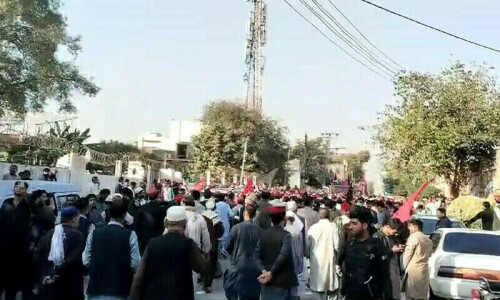PESHAWAR: Private schools have outperformed the public sector educational institutions in Peshawar district by producing better results in the last intermediate examination despite the government’s heavy spending on the latter, reveals a recent survey conducted by the elementary and secondary education department.
The survey found that the government spent Rs10,770 a month on every student enrolled in the intermediate classes of the government higher secondary schools, while the private schools charged students Rs3,000-Rs7,500 monthly fee each.
Twenty higher secondary schools from the government and private sectors each were selected for the comparison of the results of the annual FA/FSc examination taken by their students in April.
Study shows top grades in intermediate exam were secured by 66pc students of private schools and just 12pc of govt’s
The survey findings were taken up in a meeting on Oct 16, which was chaired by the then education secretary, Mukhtiar Ahmad and attended by chief planning officer of education department Idrees Azam, chairman of the Peshawar Board of Intermediate and Secondary Education Fazlur Rehman, then director education Farid Khattak and independent monitoring unit director Adeel Shah.
The meeting’s minutes, a copy of which is available with Dawn, showed that from the selected 20 government schools, 1,218 students sat the FA/FSc Part-II examination and 700 of them were declared successful putting the pass percentage at 57.4.
Of them, 12 per cent got A1, A and B grades.
However, the private schools’ students performed far better than them as 66 per cent of them obtained A1, A and B grades.
The minutes also declared that the public sector higher secondary schools didn’t produce good exam results despite huge investment by the government.
They added that the results of 12th grade examination conducted by the Peshawar educational board spoke volumes about the massive failure of the education department and teachers in improving the learning and teaching levels in government schools.
The minutes said the upgradation of a high school to the higher secondary level was very costly affair as Rs37 million was required to put up a new block and that after upgradation, the department appointed 17 teaching staff to it for intermediate classes.
They said the daily intermediate classes in the government higher secondary schools lasted four hours due to 40- minute six periods, whereas the private schools and colleges had six-hour such classes every day with eight periods having the 50 minutes duration.
It was revealed that on average, the effective teaching and learning process in higher secondary schools was not more than six months a year as the students were free for home studies in the first week of March every year, as the intermediate class teachers joined the matriculation board examination duties.
However, the intermediate course students of private schools are free for home studies 10 days before examination, while teachers are present on campus for their guidance until the summer vacation.
The academic session of private schools lasts eight months.
After thorough discussion, the participants decided that there would be seven periods each of 50 minutes duration in the government higher secondary schools, including one for practical purpose.
The education director was directed to issue a standard timetable for all government schools in this respect.
The meeting also decided that like the students of private schools, those of the government higher secondary schools would not be free for home studies 10 days before the start of the intermediate examination.
It also decided that all educational boards would design a separate cadre for examination duties on the pattern of NTS and would engage retired teachers and government officers, officials of good reputation and young university graduates for examination supervision and marking of papers to ensure the teachers’ presence in schools.
Adviser to the chief minister on E&SE Ziaullah Bangash was not available for comments.
However, an official of the education department told Dawn that the study conducted in the provincial capital’s urban areas depicted a bleak picture of the performance of the students from government schools.
“Situation of the government higher secondary schools located in far-off areas of the province is even worse than the urban areas’,” he said.
Published in Dawn, December 20th, 2018












































